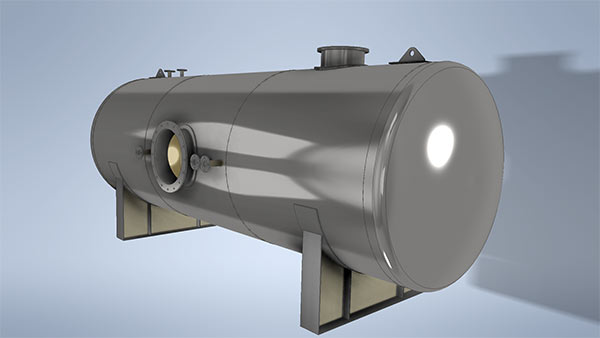Tanks and reactors
Storage containers
Storage tanks are specialized containers designed for storing a wide variety of fluids. These tanks operate at atmospheric pressure. In accordance with standard regulations, the working temperature of storage tanks should not exceed 93 degrees Celsius.
The construction material of storage tanks must be selected and engineered based on the type of fluid being stored. Common materials include carbon steel, stainless steel, polymers, and fiberglass.

Storage tanks can be categorized in several ways:
- By the type of material: The construction material is chosen in direct correlation to the stored substance.
- By appearance and geometry: Tanks are typically designed in cubic, cylindrical, or spherical shapes.
- By application and placement: Tanks are designed and built as foundational (base-mounted), portable (wheeled), vertical, or horizontal units.
The design of storage tanks adheres to various standards, with the most significant being ASME BPVC, API 620, and API 650.

Pressure Vessels
Pressure vessels differ from storage tanks in their usage, characterized by internal pressures exceeding atmospheric levels, often coupled with higher operational temperatures. These vessels are integral to various industries, including petrochemical, pharmaceutical, and food processing.
Pressure vessels are commonly utilized for storing compressed air, water, liquid gases, and chemicals such as ammonia. Additionally, they find applications in distillation towers and other high-pressure industrial processes.
The ASME Section VIII, Division 1, is the predominant standard governing the design and construction of these vital components, ensuring safety and reliability across various applications.
Pressurized reactors
These equipments are pressurized tanks in which chemical reactions are carried out. These reactions are carried out in order to change the properties of the raw materials and reach the desired materials. This pressure can be caused by the reaction itself or caused by an external source.
In pressurized reactors, we usually have higher working temperatures and these reactors can be single-walled, double-walled and with positive or negative internal pressure (vacuum). In order to speed up the reactions and better mixing of materials, various stirrers are used inside the reactors, which are circulated by electric gearboxes. Due to the high sensitivity of the work, their design and construction must be done carefully and according to the standard requirements.

